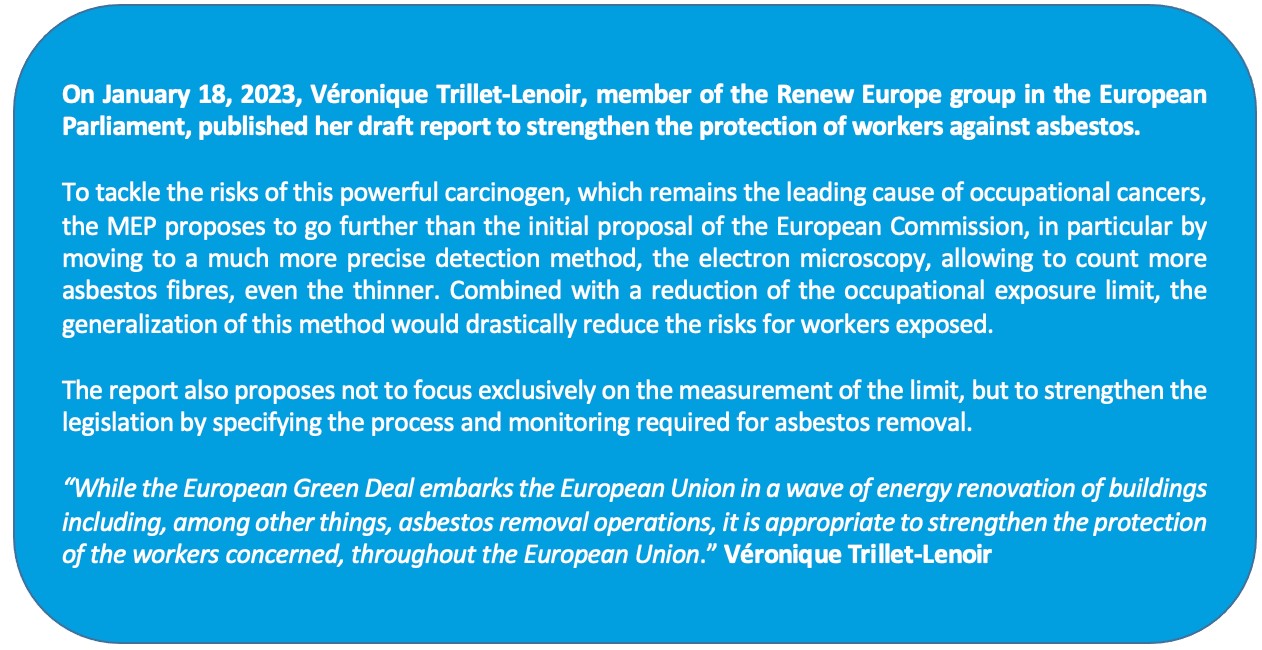Actualités
The cancer plan in action: proposals to strengthen significantly the protection of workers against asbestos


On September 28, the European Commission published its strategy for an asbestos-free Europe. This roadmap, which is part of the Europe’s Beating Cancer Plan, was largely based on the Parliament's demands for a holistic European approach, encompassing in particular housing, waste management, environmental and occupational health policies.
As the Parliament’s Rapporteur for the first legislative initiative of this strategy, Véronique Trillet-Lenoir will lead the negotiation for the European Parliament to strengthen the protection of workers against asbestos, which remains, even after its European ban in 2005, the leading cause of occupational cancers.
Today, the Renew Europe MEP presented her report: it aims at the optimal protection of workers in the concerned sectors. The starting point for the report is the observation that the methodology (phase contrast microscopy) which is recommended today to measure occupational exposure to asbestos, is outdated. More efficient methods, based on electronic microscopy, exist and allow detecting more fibres.
Two methods are currently used in electron microscopy, a more advanced technology that is currently available in a few European Union countries only:
- one, called “SEM” (Scanning Electron Microscopy), is used to monitor compliance with the lowest occupational exposure limit introduced to date, (0,002 fibres per cm³). It detects 2 to 4 times more fibres than phase contrast microscopy, but does not detect the thinner fibres.
- the other, called “TEM” (Transmission Electron Microscopy), allows the detection of the thinner fibres, and to count, on average, 15 times more fibres than with phase contrast microscopy 1.
For Véronique Trillet-Lenoir: in order to tackle the risks of asbestos, we must not repeat the mistakes of the past. For too long, the scientific evidences have been ignored, leading to a situation for which workers are still paying the price. We know that even the thinner asbestos fibres are carcinogenic. The European Chemicals Agency has even suggested that the danger may increase with decreasing width.
Following a science-based approach, Véronique Trillet-Lenoir recommends the use of the most efficient technique: transmission electron microscopy.
To reduce the risk of exposure of workers, 3 steps are proposed.
- The first, short-term step is to support the European Commission in its proposal to swiftly divide the occupational exposure limit (OEL) by ten. “It is urgent to take this step, while proposing a realistic limit, that is to say: one that can still be monitored with phase contrast microscopy”, says the MEP.
- The second step will take place as soon as transmission electron microscopy is deployed in all Member States. It will take 2 to 3 years for laboratories to equip themselves with new microscopes and train their teams. “Dividing the OEL by 10 and then introducing, after a transition period of 3 years, transmission electron microscopy, would therefore lead to a strengthening of protection by a factor of about 150 (10 x 15) compared to the current situation. This is considerable, but still technically feasible.”
- Constant efforts are needed to lower the exposure to a carcinogen with no zero-risk level like asbestos. This is why Véronique Trillet-Lenoir proposes a revision clause to further reduce the OEL, within the next 5 years.
To accompany the revision of the directive, the report proposes to specify the applicable measures to avoid the spread of dust in the air and to ensure that personal protective equipment is subject to mandatory individual fitting checks.
These practical measures will contribute to ensure compliance with the revised OEL and reduce the exposure to as low as technically feasible.
Other amendments to the asbestos directive are proposed and reflect the requests of the European Parliament expressed in a resolution of 2021.
Although the proposed revision is to increase workers protection by a factor of 150, which is absolutely considerable, focusing only on the OEL is not enough.
A prerequisite is to check, before the work, the presence or absence of asbestos in the perimeter of the planned work.
“If the announcement by the Commission of a future legislation on the screening and registration of asbestos in buildings is good news, the content is not yet known”.
The report therefore proposes to insert a clause providing, if the information is lacking or insufficient, that a screening is made by a certified operator, regardless of the type of premises: buildings or other infrastructures, such as ships.
It is also proposed to remove the concept of “sporadic or low intensity exposure”, allowing to waive certain obligations of the directive and to replace it by guidelines to provide practical sectoral information on the implementation.
The report recommends that priority be given to the removal of asbestos-containing materials rather than the use of alternatives techniques, such as encapsulation or sealing, which only postpone the removal of asbestos.
To increase awareness of the measures to be taken, it is proposed to strengthen the minimum requirements for training and notification to the competent authorities.
In order to avoid secondary exposure, the report recommends mandatory decontamination procedures.
Finally, it is proposed to update the medical surveillance provisions in the light of recent knowledge on the diseases that asbestos can give rise to.
This report is a proposal to strengthen the prevention of asbestos-related cancers for workers. It provides an ambitious but achievable and science-based roadmap to tackle with determination the leading cause of occupational cancers.
Press contact: claudie.gilot@europarl.europa.eu
[1] EYPERT-BLAISON, C., CLERC, F., ROMERO-HARIOT, A. & VINCENT, R. 2018a. Technical notes 252. Asbestos in workplace air : relevance of analysis by analytical transmission electron microscopy (tem), Paris, INRS. EYPERT-BLAISON, C., ROMERO-HARIOT, A., CLERC, F. & VINCENT, R. 2018b. Assessment of occupational exposure to asbestos fibres: Contribution of analytical transmission electron microscopy analysis and comparison with phase-contrast microscopy. J Occup Environ Hyg, 15, 263-274.


